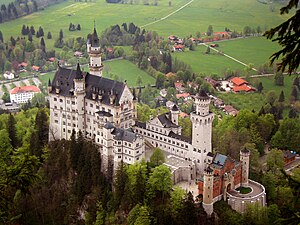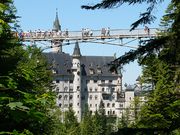Neuschwanstein Castle
From Wikipedia, the free encyclopedia
 Neuschwanstein as seen from the Marienbrücke |
|
| Schloss Neuschwanstein (German) | |
|---|---|
| Building | |
| Architectural style | Neo-romanticism |
| Town | Hohenschwangau |
| Country | Bavaria, Germany |
| Client | Ludwig II of Bavaria |
| Owner | Bavaria |
| Coordinates | Coordinates: |
| Construction | |
| Started | 5 September 1869 |
| Design team | |
| Architect | Christian Jank, Eduard Riedel, Georg Dollmann |
Neuschwanstein Castle (German: Schloss Neuschwanstein, lit. New Swan Stone palace; pronounced [nɔʏˈʃvaːnʃtaɪ̯n]) is a 19th-century Bavarian palace on a rugged hill near Hohenschwangau and Füssen in southwest Bavaria, Germany. The palace was commissioned by Ludwig II of Bavaria as a retreat and as an homage to Richard Wagner, the King's inspiring muse. Although public photography of the interior is not permitted,[1] it is the most photographed building in Germany and is one of the country's most popular tourist destinations.[2]
Ludwig did not allow visitors to his castles, but after his death in 1886 the castle was opened to the public (in part due to the need to pay off the debts Ludwig incurred financing its construction). Since that time over 50 million people have visited the Neuschwanstein Castle.[3] About 1.3 million people visit annually, with up to 6,000 per day in the summer.[4] The palace has appeared in several movies, and was the inspiration for Sleeping Beauty Castle at both Disneyland Park and Hong Kong Disneyland.
The palace is owned by the state of Bavaria, unlike nearby Hohenschwangau Castle, which is owned by the head of the house of Wittelsbach, currently Franz, Duke of Bavaria. The Free State of Bavaria has spent more than €14.5 million on Neuschwanstein's maintenance, renovation and visitor services since 1990.[4]
Contents |
[edit] History
| This section needs additional citations for verification. Please help improve this article by adding reliable references (ideally, using inline citations). Unsourced material may be challenged and removed. (July 2008) |

The conception of the palace was outlined by Ludwig II in a letter to Richard Wagner, dated May 13, 1868;
| “ | It is my intention to rebuild the old castle ruin at Hohenschwangau near the Pollat Gorge in the authentic style of the old German knights' castles... the location is the most beautiful one could find, holy and unapproachable, a worthy temple for the divine friend who has brought salvation and true blessing to the world. | ” |
The foundation stone of the building was laid September 5, 1869. Neuschwanstein was designed by Christian Jank, a theatrical set designer, rather than an architect, which says much regarding Ludwig's intentions and explains much of the fantastical nature of the resulting building. The architectural expertise, vital to a building in such a perilous site, was provided first by the Munich court architect Eduard Riedel and later by Georg Dollmann, son-in-law of Leo von Klenze.
The palace was originally called New Hohenschwangau Castle until the king's death, when it was re-named Neuschwanstein, the castle of the Swan Knight Lohengrin, of Wagner's opera of the same name. In origin, the palace has been the Schwanstein, the seat of the knights of Schwangau, whose emblem had been the swan.
Neuschwanstein was near completion when, in 1886, the King was declared insane by a State Commission under Dr. von Gudden and arrested at the palace. The King could hardly control himself as he asked von Gudden, "How can you declare me insane? You have not yet examined me!"[5] Taken to Castle Berg, he was found on June 13, 1886, in shallow water in Lake Starnberg, drowned, along with von Gudden, the psychiatrist who certified him. The exact circumstances of his and von Gudden's deaths remain unexplained. It is generally thought[who?] that Ludwig's deposition was brought about by the Wittlesbachs in response to his extravagance with the dynasty's private funds in projects such as Neuschwanstein.[citation needed]
[edit] Architecture
| This section needs additional citations for verification. Please help improve this article by adding reliable references (ideally, using inline citations). Unsourced material may be challenged and removed. (July 2008) |
The palace comprises a gatehouse, a Tower, the Knight's House with a square tower, and a Palas, or citadel, with two towers to the Western end. The effect of the whole is highly theatrical, both externally and internally.[citation needed] The king's influence is apparent throughout, and he took a keen personal interest in the design and decoration. An example can be seen in his comments, or commands, regarding a mural depicting Lohengrin in the Palas; "His Majesty wishes that … the ship be placed further from the shore, that Lohengrin's neck be less tilted, that the chain from the ship to the swan be of gold and not of roses, and finally that the style of the castle shall be kept medieval."[citation needed]
The suite of rooms within the Palas contains the Throne Room, Ludwig's suite, the Singers' Hall, and the Grotto. Throughout, the design pays homage to the German legends of Lohengrin, the Swan Knight. Hohenschwangau, where Ludwig spent much of his youth, had decorations of these sagas. These themes were taken up in the operas of Richard Wagner. Many rooms bear a border depicting the various operas written by Wagner, including a theater permanently featuring the set of one such play. Many of the interior rooms remain undecorated, with only 14 rooms finished before Ludwig's death.[6] With the palace under construction at the King's death, one of the major features of the palace remained unbuilt. A massive keep was planned for the middle of the upper courtyard but was never built, at the decision of the King's family. The foundation for the keep is visible in the upper courtyard.
The finished rooms include the throne room, which features a glass gem-encrusted chandelier; all Twelve Apostles and six canonised kings are painted on the wall that surrounds the pedestal for the throne - the actual throne was never finished; and Jesus, behind the pedestal. This reflects Ludwig's view of himself as king, by the grace of God. The King's master suite includes a four-post bed hand carved of wood, the canopy of which is carved as the cathedral towers from every cathedral in Bavaria, a secret flushing toilet (which flushes with water collected from an aqueduct) and a running sink in the shape of a swan. The hand carved wood was very detailed and adorned the entire room, causing the master suite to take 10 years to complete. The palace also includes an oratory, accessible from the dressing room and the master suite, which features an ivory crucifix, a room made to look like a cavern, a full kitchen equipped with hot and cold running water and heated cupboards, servants' quarters, a study, a dining room and the Singers' Hall. The Singers' Hall is a venue for performances by musicians and playwrights. The King built it for Wagner as a place to write and perform plays. The King died before watching a performance in the Singers' Hall, but it has been used since the King's death.
Despite its medieval look, the construction of Neuschwanstein required the modern technology of the day, and the palace is a marvel of technological structural achievements. Steam engines, electricity, modern venting, a modern water system on all floors, and heating pipes are all part of the structure.
It is now almost forgotten that Ludwig II was a patron of modern inventions and that he pioneered the introduction of electricity into public life in Bavaria. His new palaces were the first buildings to use electricity (i.e. the Venus Grotto at Linderhof) and other modern conveniences. Through his building activities, Ludwig kept many particular crafts alive, the knowledge and expertise of which would have died out otherwise, and he provided work and income to artisans, builders, plasterers, and decorators.
[edit] In popular culture
- A mirrored image of Neuschwanstein is featured on the cover of the Blur single "Country House".
- Neuschwanstein is featured in the movies The Great Escape, Chitty Chitty Bang Bang, Space Balls and The Wonderful World of the Brothers Grimm.
- Neuschwanstein and its interiors were heavily featured in the video game The Beast Within: A Gabriel Knight Mystery.[7]
- Neuschwanstein is to appear on a €2 commemorative coin for the German Bundesländer series in 2012.
- In 2007, it was a finalist in the selection of the New Seven Wonders of the World.[8] As it was not voted on the top positions it now is advertised as the 8th world wonder.
- In the Game Cube remake of Resident Evil Neuschwanstein is seen several times throughout the game in various paintings in the background. It is supposed to represent the Spencer Mansion, though it bears no similarities to the in-game rendering of the mansion.[citation needed]
- Neuschwanstein is one of the locations featured in the arcade game City Connection.
- In the computer games SimCity 3000 and SimCity4, Neuschwanstein is one of the landmark buildings featured in the game.
- In the eighth Pokemon Movie, a castle similar to Neuschwanstein is portrayed.
[edit] References
- ^ "Neuschwanstein Castle: Tourist info". http://www.neuschwanstein.com/englisch/tourist/index.htm. Retrieved on 2008-12-26.
- ^ "Dummies::Neuschwanstein and Hohenschwangau: Castles in the Air". Adapted From: Germany For dummies 2nd Edition. http://www.dummies.com/WileyCDA/DummiesArticle/id-3149.html. Retrieved on 2006-06-09.
- ^ "Information about Ludwig on the Neuschwanstein official website". http://www.neuschwanstein.de/english/castle/ludwig/index.htm. Retrieved on 2008-01-26.
- ^ a b "General information about Neuschwanstein on the official website". http://www.neuschwanstein.de/english/castle/neuschwanstein.htm. Retrieved on 2007-12-27.
- ^ Sailer, Anton, Castles, Mystery, and Music, the Legend of Ludwig II, Munich, 1983 reprint: 136, ISBN 3-7654-1898-6
- ^ Desing, Julius (1998). Bonny Schmid-Burleson (trans.). ed. The Royal Castle of Neuschwanstein. Lechbruck, Germany: Verlag Wilhelm Kienberger.
- ^ Walkthrough of The Beast Within: A Gabriel Knight Mystery with details about featuring Neuschwanstein Castle
- ^ "Neuschwanstein Castle at New7wonders,". http://www.new7wonders.com/classic/en/n7w/finalists/c/NeuschwansteinCastle/. Retrieved on 2008-01-26.
- Blunt, Wilfred, The Dream King - Ludwig II of Bavaria, Hamish Hamilton, London, 1970, ISBN 241-01899-4
- Neuschwanstein Castle - the Official Guide, Bayerische Schlosseverwaltung, undated.
- Spangenberg, Marcus, (English Translation Katherine Vanovitch) "The Throne Room in Schloss Neuschwanstein. Ludwig II of Bavaria and his Vision of Divine Right, [Schnell & Steiner], Regensburg, 1999, ISBN 3-7954-1233-1
[edit] External links
| Wikimedia Commons has media related to: Neuschwanstein Castle |
- Official website
- Bavarian Palace Department Page of Neuschwanstein (English)
- Neuschwanstein Castle dedicated site
|
||||||||





